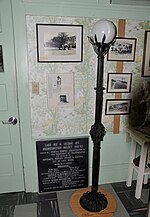College Park Historic District (Lake Worth, Florida)
Buildings and structures in Lake Worth Beach, FloridaHistoric districts on the National Register of Historic Places in FloridaNRHP infobox with nocatNational Register of Historic Places in Palm Beach County, FloridaPalm Beach County, Florida Registered Historic Place stubs ... and 1 more
Use mdy dates from August 2023

The College Park Historic District (also known as College Park Residential Neighborhood) is a U.S. historic district (designated as such on February 9, 2001) located in Lake Worth Beach, Florida. The district is bounded by Maryland Drive, North Federal Highway, 19th Avenue North, and North Dixie Highway. It contains 90 historic buildings and residences.
Excerpt from the Wikipedia article College Park Historic District (Lake Worth, Florida) (License: CC BY-SA 3.0, Authors, Images).College Park Historic District (Lake Worth, Florida)
Pennsylvania Drive,
Geographical coordinates (GPS) Address Nearby Places Show on map
Geographical coordinates (GPS)
| Latitude | Longitude |
|---|---|
| N 26.641013888889 ° | E -80.054411111111 ° |
Address
Pennsylvania Drive 2257
33460
Florida, United States
Open on Google Maps









